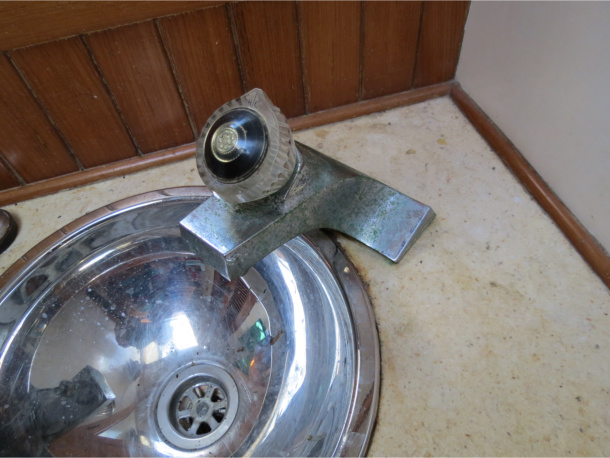The Blue View - Faucet Replacement
/We have a pressurized water system aboard Nine of Cups. There is a small water pump that connects the water tanks to each of the faucets, and when we turn a faucet handle, the water pressure in the lines drops, causing the water pump to come on. So, when everything is working well, our faucets work just like those in a house. We also have a foot pump at the galley sink as a backup, in case we have a problem with the pressurized system.
The water pump is loud enough to be heard, under normal conditions, throughout the boat. You might think this would be undesirable, but it is actually a good thing. The pump should not come on unless a faucet is opened. If we hear the pump and no faucet is open, we know we have a leak somewhere. And so it was about a week ago - the water pump was cycling on and off for a second or two about once an hour – a sure sign of a leak.
Sometimes the leak is difficult to track down, since the pressurized lines run through a number of hard-to-get-to areas, but this time it was pretty easy. The shelf under the sink in the forward head was wet, and the fittings connected to the faucet were corroded. That particular faucet had been replaced several years ago with a household bar sink faucet. Household faucets are pretty and usually less expensive than marine grade faucets, but have a limited lifetime aboard a boat. In addition, since household faucets are designed to connect to household plumbing, which is usually different than boat plumbing, it is sometimes a challenge finding the right fittings to make the connections.
The faucet was definitely showing its age both above and below the counter, so we went in search of a replacement. The counter is some sort of a marble-like substance, and quite difficult to drill or cut, so we were hoping to find something that would fit the old holes. This, of course, didn't work out, but we did find a nice marine grade faucet at Whitworth's (the Aussie equivalent of West Marine), with a removable spout that can be used as a shower head. While it wouldn't fit the same holes, at least it would cover the old ones, so we bought it. It really doesn't look as nice as a conventional sink faucet, but at least it costs twice as much.
As is typical of most of my projects, what should have taken an hour or two took closer to two days. I needed to convert the two drilled holes into a rectangular cutout, and the marble-like counters were even harder to cut than I expected. I tried hole saws, my multi-tool with a saw blade and my Dremel with a cut-off wheel, but none of the power tools seemed to make much of a dent in the counter. After drilling for 45 minutes with the hole saw, for example, I had completely worn it out and had only a 1/2” deep hole to show for my effort. It was too small an area to use a jig saw. I contemplated making a trip to the local Bunnings to see if I could find some diamond tipped tile cutting bits, but it's a three-hour round trip by train and bus, with no guarantee that they had the bits or that the bits would cut any better.
Eventually, I found that a hacksaw blade worked as well or better than anything else. It didn't exactly fly through the counter – it took 15 minutes of concerted effort to cut 1/8” (3mm) but it did make progress. I drilled 1/4” holes to make the radii in the corners, and used a chisel to connect the dots. After a day and a half of sawing, drilling, sweating and swearing, I finally finished the cutout.
The rest of the job was pretty straightforward. I masked the faucet and caulked under it with silicone, then screwed it into place. The plumbing connections were easy – 1/2” reinforced vinyl tubing held in place with double hose clamps. When I turned the pump back on, no leaks and the pump now only comes on when it should. Another “two hour” project to check off the list. Actually, it wasn't on the list to begin with, so I had to add it to the to-do list before I could check it off.





